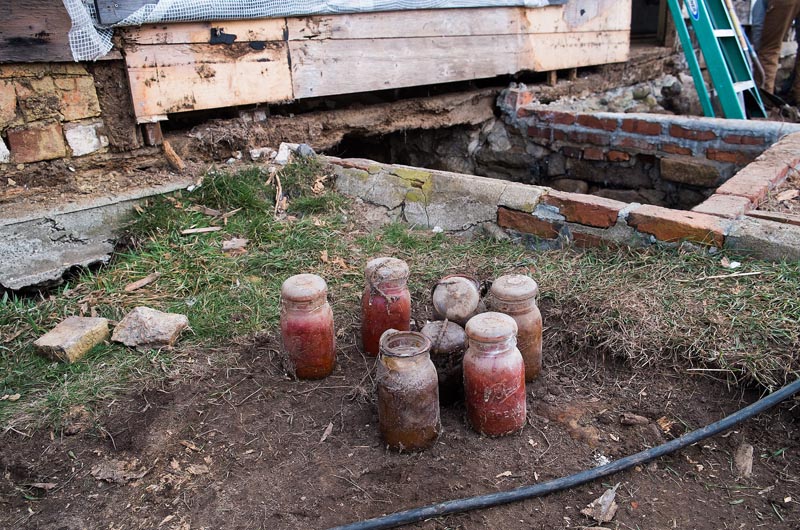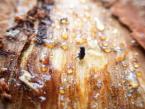At the end of a long dirt road in Chilmark, a huge white tent arches above the meadows at Quansoo Farm. Inside the tent is the historic Mayhew-Hancock-Mitchell House, which has been under renovation since last year. The site resembles an archaeological dig as well as a construction site — and essentially it is both.
On a recent morning, workers were busy inside the tent, preparing new timber for the modest farmhouse, which is owned by the Sheriff’s Meadow Foundation. The partly disassembled house now rests on new wooden sills atop the original foundation, which is exposed in a shallow ditch below the house.
“The house is very old and parts of it are made of mud,” said Adam Moore, director of the foundation, which has raised most of the $1 million needed for the project. “And you really can’t have that exposed to the elements while we work on it because it will melt,” he said.
The tent, a building in itself, with doors, lighting and a concrete foundation, keeps the house safe from the elements and allows for work to continue year round. The Cooper Group of Pawcatuck, Conn., is the primary contractor for the project.
Surrounding the tent were piles of planks and beams: white oak timbers from Cedar Tree Neck that were sawed by Carlton and Nate Sprague of Tisbury; a pile of white pine timber donated by Ellen and Ed Harley and sawed by Tom Turner in Edgartown; and planks for sheathing and sub-flooring that were planed at the Gannon and Benjamin boatyard in Tisbury.
Much of the existing wood in the house has rotted, including the floor joists. “If they are not rotten, we try to fix it and use whatever we can of the existing house,” Mr. Moore said. Wherever possible, new materials will be locally sourced.
Sheriff’s Meadow had originally dated the house to the mid 1600s, which would make it among the oldest houses on the Vineyard. Some have suggested that the house was built by the Island missionary Thomas Mayhew in the middle of the 17th century. But an archaeological study over the last several months has shed new light on the past for the old house. Myron Stachiw, a historian and archaeologist from Connecticut who has worked with museums and historic groups around New England, began studying the house last winter. This winter, he plans to complete a structural report for Sheriff’s Meadow, as well as a nomination paper to have the house added to the National Registry of Historic Places.
“Over the last 10, 15 years, there have been some questions raised about the age of building,” he said. “Is it really the oldest house on the Island? What is its date of construction and use?”
To answer those questions, he used a process called building archaeology, or forensic architectural history, to carefully peel away the layers of the house. He consulted with Jim Tuck and Dick Burt, well-known archaeologists and Island residents, to trace the ownership of the property, and to find any evidence of how and when the house was built.
“The big surprise was that the house was probably constructed somewhere between 1750 and 1770,” Mr. Stachiw said. The house also was built somewhere else before being moved to its present site in the late 1790s. And contrary to some earlier theories, the house was not originally a one-room building, but a half Cape that was later enlarged to full Cape size. An L-shaped structure was added to the back of the house in 1837.
The archeological work is mostly complete, but researchers will return Monday to excavate around the central chimney to determine what sort of oven might have been there. Their work is helping to guide the restoration, by providing such details as the size of the windows and style of trim. New features of the building will be made to match the earlier styles.
One method used to date the different sections was to count the growth rings in the house’s wooden beams and compare them to other samples, a process called dendrochronology. But that didn’t yield any precise dates, since the beams had decayed and lost their outer growth rings. “What it did give very reliably was that the older half was about 46 years older than newer half,” Mr. Stachiw said. New sills underneath the floors will be inscribed with their date of installation for the sake of future historians.
Based on the type of construction and materials used inside the house, researchers dated the newer half to the first two decades of the 19th century. Referring back to the tree-ring data, that meant the older half was built in the mid 1700s — about 100 years later than was previously thought.
“What’s really interesting about the building is that it continues to use — at that late date of the mid 18th century — features that were commonly used in the late 17th century, into the very early 18th century,” Mr. Stachiw said. On the mainland, many of those features were absent after the 1720s. But with its relative isolation and more conservative nature, the Vineyard was slower to change. And Quansoo Farm itself, eight miles from town, on land controlled by the Mayhews, was one of the more conservative regions on the Island.
The Vincent House in Edgartown is another example of the kind of “old-fashioned” architecture found at Quansoo. The Vincent House has been dated to 1672, but Mr. Stachiw said there was “considerable evidence” that it, too, was built in the early 18th century.
Materials recovered from underneath and around the Quansoo house were all from the late 1700s, suggesting that the oldest part of the house had been built elsewhere. But researchers don’t know where. James Hancock, who purchased the property in 1792, the year before he married, left behind no surviving documents related to the move or the purchase of the house.
Mr. Moore said it would have been impossible to move the house prior to the renovation, due to the level of decay. But with new sills below the house, relocation is again possible. “We’re guessing that in 100 years we probably will have to move it, just because the ocean keeps moving closer,” Mr. Moore said. “But this will enable us to do that in this time frame.”
Other clues to the house’s past were discovered within its walls. A piece of newspaper from New Bedford dating to around 1837 was found in one of the walls of the L-shaped addition. “So that corresponds pretty well to around the time we thought that L was put on,” Mr. Moore said.
The house is among a handful in the country — all in Massachusetts — whose walls were made with wattle and daub type construction. In this method, oak splints were wedged between posts to form a lattice, or wattle, and the spaces were filled with daub — a mixture of clay, chopped straw and sheep dung. The Vincent House, and perhaps one or two others on the Island, have wattle and daub construction.
Unlike most restoration projects, which focus on high-end properties, the Quansoo house “is a pretty simple farmhouse,” Mr. Stachiw said. Its various inhabitants had one of the largest and most valuable farms in Chilmark, he added, “but they were not particularly stylish people, and it clearly shows in the building, in the way they maintained it.”
“It was actually poverty through the first half of the 20th century that probably preserved this building more than anything else,” he said. “They didn’t improve it, it wasn’t sold to somebody who turned it into a summer home and completely modernized it and transformed it. It essentially maintained its character from the 18th and early 19th century.”
Mr. Moore said the goal is to finish most of the work by May, with landscaping and a new chimney to come later.
The Sheriff’s Meadow Foundation has offered educational tours of the house, and Mr. Moore hoped those tours would continue. One option for the restoration is to be able to swing open portions of the walls or door frames, or install glass panels to reveal the layers within.
Mr. Stachiw said the house will be a valuable resource for scholars and anyone interested in old buildings. “It preserves something that very rarely survives the way it has survived in that building,” he said. “We can really see how things happened.”












Comments (3)
Comments
Comment policy »